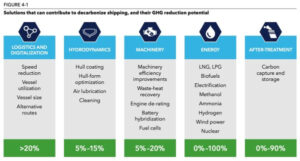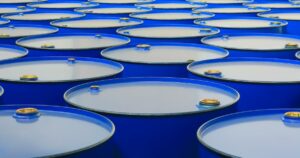
As alternative proteins become mainstream parts of grocery stores and lab-grown meat scores regulatory wins, this new protein alternative is starting to make some noise — creating food from captured CO2.
Similar to lab-grown meat, protein from CO2 is produced in bioreactors using fermentation. But instead of trying to re-create animal protein cells, the process generates a protein flour.
“Our process is very similar to growing plants,” said Lisa Dyson, founder of Air Protein. “But instead of a multicellular organism, like a plant, [it creates] a single celled organism in a matter of hours. We’re essentially feeding the elements that make up that protein molecule to the organism, and the organism reshuffles everything to make that protein.”
Air Protein’s inputs include oxygen, CO2 and nitrogen, all elements found in the air. It uses naturally occurring bacteria cultures to create the proteins. The flour can then be used as an ingredient to make everything from alternative chicken products such as “chicken nuggets” to protein pastas.
Solar Foods, a food-from-CO2 startup based in Finland, uses CO2 collected from a calcium chloride factory and combines it with nitrogen to make its version. The company uses an electrolyzer to create hydrogen from water molecules as a renewable energy source for the fermentation process.
“It’s pretty much the same as making baker’s yeast or lactic acid starter culture for yogurt,” said Juha-Pekka Pitkänen, Solar Foods’ founder and chief technology officer.
The startup’s product, Solein, is a yellow powder of about 60 to 70 percent protein (with the rest being fatty acids and dietary fibers) that has a neutral umami flavor, according to Pitkänen.
Moving CO2 food into the mainstream diet
Solar Foods plans to sell its protein powder as an ingredient to food producers who will create everything from soft cheeses to meat alternatives. In October, Solar Foods got commercial approval to sell its product in Singapore, where Solein is being used in ice cream. In 2024, the company plans to scale up its capacity to 20,000 liters (from its current 200 liters) with a new facility in Helsinki. With this scaling, Pitkänen thinks Solein can be cost-competitive with pea proteins at around $3 to $6 per kilo.
For Air Protein, it has created an Air Chicken alternative meat product from its flour and is soon to move into pasta and protein shakes. Its scaling plans include teaming up with food manufacturing giant ADM to create its first commercial facility in San Leandro, California.
CO2 protein is decoupling from farmland, and that helps with supply chain security.
Creating food from CO2 could solve two problems at once: the sustainable food crisis and our emissions woes. Instead of pulling carbon out of the air just to store it underground, why not make the most important product in the world from it?
“We’re decoupled from agriculture,” Dyson said of the process. “We’re decoupling from farmland, and that helps with supply chain security.”
Because of food from carbon’s ability to be disconnected from traditional agriculture land, Air Protein is working with the U.S. Department of Defense’s Defense Advanced Research Projects Agency on creating a food supply chain that could work in crisis areas such as war zones or after environmental disasters to make food quickly and with less resources.
Creating protein from CO2 is also less resource-intensive and could produce fewer carbon emissions than traditional farming that requires lots of land, fertilizers, water and labor. The biggest cost for CO2 protein producers is energy. Solar Foods uses renewable energy to continue to cut down on any residual emissions, but that does make the process expensive.
“This is just a new way of making food,” Dyson said. “How are we going to continue to find arable land [for food production] when we go from 8 billion people today to 10 billion people tomorrow? Where’s the rest of that land going to come? It’s going to come from deforestation. This helps avoid that.”
- SEO Powered Content & PR Distribution. Get Amplified Today.
- PlatoData.Network Vertical Generative Ai. Empower Yourself. Access Here.
- PlatoAiStream. Web3 Intelligence. Knowledge Amplified. Access Here.
- PlatoESG. Automotive / EVs, Carbon, CleanTech, Energy, Environment, Solar, Waste Management. Access Here.
- PlatoHealth. Biotech and Clinical Trials Intelligence. Access Here.
- ChartPrime. Elevate your Trading Game with ChartPrime. Access Here.
- BlockOffsets. Modernizing Environmental Offset Ownership. Access Here.
- Source: https://www.greenbiz.com/article/creating-food-out-thin-air
- :has
- :is
- :not
- :where
- $3
- $UP
- 000
- 10
- 20
- 200
- 2024
- 60
- 7
- 70
- 8
- a
- ability
- About
- According
- address
- advanced
- After
- agriculture
- AIR
- All
- also
- alternative
- alternatives
- an
- and
- animal
- any
- appeared
- ARE
- areas
- around
- article
- AS
- At
- avoid
- Bacteria
- baker
- based
- BE
- become
- being
- Biggest
- Billion
- but
- california
- CAN
- Capacity
- captured
- carbon
- carbon emissions
- Cells
- chain
- chief
- chief technology officer
- Climate
- climate crisis
- co2
- combines
- come
- commercial
- company
- Connect
- continue
- Cost
- could
- Cream
- create
- created
- creates
- Creating
- crisis
- Culture
- Current
- Cut
- darpa
- decoupled
- Defense
- deforestation
- Department
- dialogue
- disasters
- disconnected
- does
- down
- elements
- Emissions
- energy
- environmental
- essentially
- Ether (ETH)
- Every
- everything
- expensive
- Facility
- factory
- farming
- farmland
- feeding
- fewer
- fibers
- Find
- Finland
- First
- food
- food supply
- food supply chain
- foods
- For
- found
- founder
- from
- generates
- get
- giant
- Go
- going
- grocery
- Growing
- helps
- HOURS
- How
- HTTPS
- hydrogen
- ICE
- ice cream
- important
- in
- include
- inputs
- instead
- into
- IT
- ITS
- just
- labor
- Land
- leaders
- LEARN
- less
- like
- Mainstream
- make
- Making
- manufacturing
- Matter
- Meat
- molecule
- more
- most
- move
- much
- Neutral
- New
- news
- node
- Noise
- occurring
- Oct
- october
- of
- Officer
- on
- once
- or
- originally
- our
- out
- Oxygen
- part
- parts
- People
- per
- percent
- Place
- plans
- plants
- plato
- Plato Data Intelligence
- PlatoData
- pretty
- problems
- process
- produce
- Produced
- Producers
- Product
- Production
- Products
- projects
- Protein
- Proteins
- pulling
- quickly
- RE
- regulatory
- Renewable
- renewable energy
- requires
- research
- resource-intensive
- Resources
- REST
- s
- Said
- same
- San
- San Jose
- Scale
- scaling
- security
- sell
- similar
- Singapore
- single
- Soft
- solar
- SOLVE
- some
- Soon
- Source
- Starting
- startup
- store
- stores
- subscribe
- such
- supply
- supply chain
- Sustainability
- sustainable
- taking
- Technology
- than
- that
- The
- the world
- then
- thin air
- Thinks
- this
- thousands
- thursday
- to
- today
- together
- tomorrow
- traditional
- two
- used
- uses
- using
- version
- very
- want
- war
- Water
- Way..
- we
- when
- WHO
- why
- will
- with
- Work
- working
- world
- yellow
- Your
- zephyrnet
- zones










